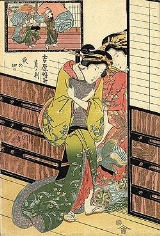
Kunisada
Encyclopedia
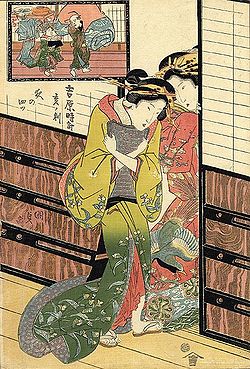
Ukiyo-e
' is a genre of Japanese woodblock prints and paintings produced between the 17th and the 20th centuries, featuring motifs of landscapes, tales from history, the theatre, and pleasure quarters...
woodblock prints
Woodblock printing in Japan
Woodblock printing in Japan is a technique best known for its use in the ukiyo-e artistic genre; however, it was also used very widely for printing books in the same period. Woodblock printing had been used in China for centuries to print books, long before the advent of movable type, but was only...
in 19th-century Japan
Japan
Japan is an island nation in East Asia. Located in the Pacific Ocean, it lies to the east of the Sea of Japan, China, North Korea, South Korea and Russia, stretching from the Sea of Okhotsk in the north to the East China Sea and Taiwan in the south...
. In his own time, his reputation far exceeded that of his contemporaries, Hokusai
Hokusai
was a Japanese artist, ukiyo-e painter and printmaker of the Edo period. He was influenced by such painters as Sesshu, and other styles of Chinese painting...
, Hiroshige
Hiroshige
was a Japanese ukiyo-e artist, and one of the last great artists in that tradition. He was also referred to as Andō Hiroshige and by the art name of Ichiyūsai Hiroshige ....
and Kuniyoshi.
Evaluation of Kunisada in art history
At the end of the Edo PeriodEdo period
The , or , is a division of Japanese history which was ruled by the shoguns of the Tokugawa family, running from 1603 to 1868. The political entity of this period was the Tokugawa shogunate....
(1600 – 1867), Hiroshige, Kuniyoshi and Kunisada were the three best representatives of the Japanese color woodcut in Edo (capital city of Japan, now Tokyo
Tokyo
, ; officially , is one of the 47 prefectures of Japan. Tokyo is the capital of Japan, the center of the Greater Tokyo Area, and the largest metropolitan area of Japan. It is the seat of the Japanese government and the Imperial Palace, and the home of the Japanese Imperial Family...
). However, among European and American collectors of Japanese prints, beginning in the late 19th and early 20th century, all three of these artists were actually regarded as rather inferior to the greats of classical ukiyo-e, and therefore as having contributed considerably to the downfall of their art. For this reason, some referred to their works as “decadent”.
Beginning in the 1930’s and 1970’s, respectively, the works of Hiroshige and Kuniyoshi were submitted to a re-evaluation, and these two are now counted among the masters of their art. Thus, from Kunisada alone was withheld, for a long time, the acknowledgment which is due to him. With a few exceptions, such as actor portraits (yakusha-e
Yakusha-e
Yakusha-e , often referred to as "actor prints" in English, are Japanese woodblock prints or, rarely, paintings, of kabuki actors, particularly those done in the ukiyo-e style popular through the Edo period and into the beginnings of the 20th century...
) and portraits of beautiful women (bijinga
Bijinga
Bijinga , is a generic term for pictures of beautiful women in Japanese art, especially in woodblock printing of the ukiyo-e genre, which predate photography...
), at the beginning of his career, and some series of large-size actor head-portraits near the end, it was thought that he had produced only inferior works. It was not until the early 1990’s, with the appearance of Jan van Doesburg’s overview of the artistic development of Kunisada, and Sebastian Izzard’s extensive study of his work, that this picture began to change, with Kunisada more clearly revealed as one of the “giants” of the Japanese print that he was.
Biography
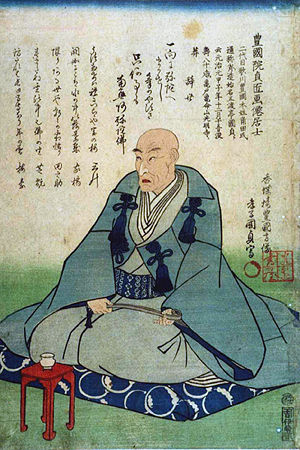
Edo
, also romanized as Yedo or Yeddo, is the former name of the Japanese capital Tokyo, and was the seat of power for the Tokugawa shogunate which ruled Japan from 1603 to 1868...
. His given name was Sumida Shōgorō IX (角田庄五朗), and was also called Sumida Shōzō (角田庄蔵). A small licensed and hereditary ferry-boat service belonged to his family, and the income derived from this business provided a certain basic financial security. His father, who was an amateur poet of some renown, died in the year after his birth. While growing up as a half-orphan, it seems he developed an early talent for painting and drawing .
His early sketches at that time impressed Toyokuni
Toyokuni
Utagawa Toyokuni , also often referred to as Toyokuni I, to distinguish him from the members of his school who took over his gō after he died, was a great master of ukiyo-e, known in particular for his Kabuki actor prints...
, the great master of the Utagawa school
Utagawa school
The was a group of Japanese woodblock print artists, founded by Toyoharu. His pupil, Toyokuni I, took over after Toyoharu's death and raised the group to become the most famous and powerful woodblock print school for the remainder of the 19th century....
and prominent designer of kabuki
Kabuki
is classical Japanese dance-drama. Kabuki theatre is known for the stylization of its drama and for the elaborate make-up worn by some of its performers.The individual kanji characters, from left to right, mean sing , dance , and skill...
and actor-portrait prints. In the year 1800 or shortly thereafter Kunisada was accepted by Toyokuni I as an apprentice in his workshop. In keeping with a tradition of Japanese master-apprentice relations, he was then given the official artist name of “KUNI-sada”, the first character of which was derived from the second part of the name “Toyo-KUNI”.
His first known print dates to the year 1807, however this seems to have been an exceptional design, and further full-sized prints appear starting only in 1809 - 1810. However as of 1808 he had already begun work as an illustrator of ehon (woodblock print illustrated books) and his popularity was fast increasing. In 1809 he was referred to in contemporary sources as the “star attraction” of the Utagawa school, and soon thereafter was considered as at least equal to his teacher Toyokuni in the area of book illustration.
Kunisada’s first actor portraits appeared in either 1808 or 1809. It is known that his first bijinga series and a series of pentaptychs showing city scenes of Edo, appear simultaneously in 1809. By 1813 he had risen as a “star” in the constellation of Edo’s artistic world (a contemporary list of the most important ukiyo-e artists places him in second place behind Toyokuni I) and until his death in early 1865, Kunisada remained one of the “trendsetters” of the Japanese woodblock print.
Beginning around 1810 Kunisada used the studio name “Gototei”, which refers cryptically to his father’s ferry-boat business. Until 1842 this signature appeared on nearly all of his kabuki designs. Around 1825 the studio name “Kochoro” appeared, and was often used on prints not related to kabuki. This name was derived from a combination of the pseudonyms of master painter Hanabusa Itcho, and that of his successor Hanabusa Ikkei, with whom Kunisada had studied a new style of painting around 1824 - 1825.
In 1844, he finally adopted the name of his master Toyokuni I, and for a brief time used the signature “Kunisada becoming Toyokuni II". Starting in 1844-1845, all of his prints are signed “Toyokuni” (partially with the addition of other studio names as prefixes, such as “Kochoro” and “Ichiyosai”). Although Kunisada referred to himself as “Toyokuni II”, he must be regarded, however, as “Toyokuni III”. The question is unsettled as to why he intentionally ignored the fact that Toyoshige (pupil and son-in-law of Toyokuni I) had borne the name “Toyokuni”, as legitimate head of the Utagawa school, from 1825 until his own death in 1835.
The date of Kunisada's death was the 15th day of the 12th month of the First Year of Genji. Most sources erroneously report this as having been in the year 1864. In fact, this date in the Chinese/Japanese calendar corresponds to the date January 12, 1865, in our Western calendar. Kunisada died in the same neighborhood in which he had been born.
Artistic activity
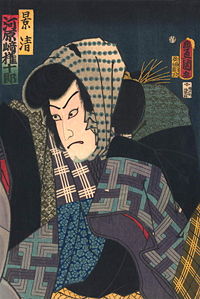
His productivity was extraordinary. As of this writing, approximately 14,500 individual designs have been catalogued (multi-ptych sets counted as a single design) corresponding to more than 22,500 individual sheets. It seems probable based on these figures that Kunisada actually produced between 20,000 and 25,000 designs for woodblock prints during his lifetime (i.e. 35,000 to 40,000 individual sheets).

Sumo
is a competitive full-contact sport where a wrestler attempts to force another wrestler out of a circular ring or to touch the ground with anything other than the soles of the feet. The sport originated in Japan, the only country where it is practiced professionally...
wrestlers. For a long time (1835-1850) he had an almost complete monopoly on the genre of Genji
The Tale of Genji
is a classic work of Japanese literature attributed to the Japanese noblewoman Murasaki Shikibu in the early 11th century, around the peak of the Heian period. It is sometimes called the world's first novel, the first modern novel, the first psychological novel or the first novel still to be...
prints, it was only after 1850 that other artists began to produce similar designs. Noteworthy also are the number of his surimono
Surimono
are a genre of Japanese woodblock print. They were privately commissioned for special occasions such as the New Year. Surimono literally means "printed thing". Being produced in small numbers for a mostly educated audience of literati, surimono were often more experimental in subject matter and...
, although they were designed almost exclusively prior to 1844, few artists were better-known in this area.
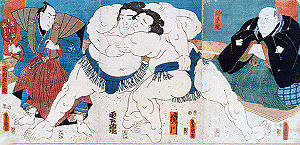
Shunga
' is a Japanese term for erotic art. Most shunga are a type of ukiyo-e, usually executed in woodblock print format. While rare, there are extant erotic painted handscrolls which predate the Ukiyo-e movement...
pictures, which appeared in numerous books, but due to censorship, signed only on the title page with his alias “Matahei”. Landscape prints and musha-e (samurai warrior prints) by Kunisada are rare, and only about 100 designs in each of these genres are known. He effectively left these two fields to be covered by his contemporaries Hiroshige and Kuniyoshi, respectively.
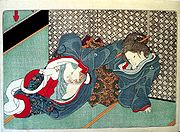
Tenpo reforms
The were an array of economic policies introduced in 1842 by the Tokugawa Shogunate in Japan.These reforms were efforts to resolve perceived problems in military, economic, agricultural, financial and religious systems....
. Also beginning around the mid-1850’s there are series in which individual parts of designs (and sometimes complete sheets) are signed by Kunisada’s students, this was done with the intention of promoting their work as individual artists. Notable students of Kunisada included Toyohara Kunichika
Kunichika
was a Japanese woodblock print artist. Talented as a child, at about thirteen he became a student of Tokyo's then-leading print maker, Utagawa Kunisada...
, Utagawa Sadahide and Utagawa Kunisada II
Utagawa Kunisada II
Utagawa Kunisada II was a Japanese ukiyo-e printmaker, one of three to take the name "Utagawa Kunisada."A pupil of Utagawa Kunisada I, he signed much of his early work "Baidō Kunimasa III." He took the name Kunisada after marrying his master's eldest daughter in 1846. He changed his name once more...
.
External links
- The Utagawa Kunisada Project Overview of Kunisada's work with thousands of pictures, series titles, lists of actors and kabuki dramas portrayed by Kunisada, and detailed study of his artistic names and signatures. During his lifetime, he produced a staggering number of prints, so that even a partial list includes nearly 1,000 series.
- Kunisada

